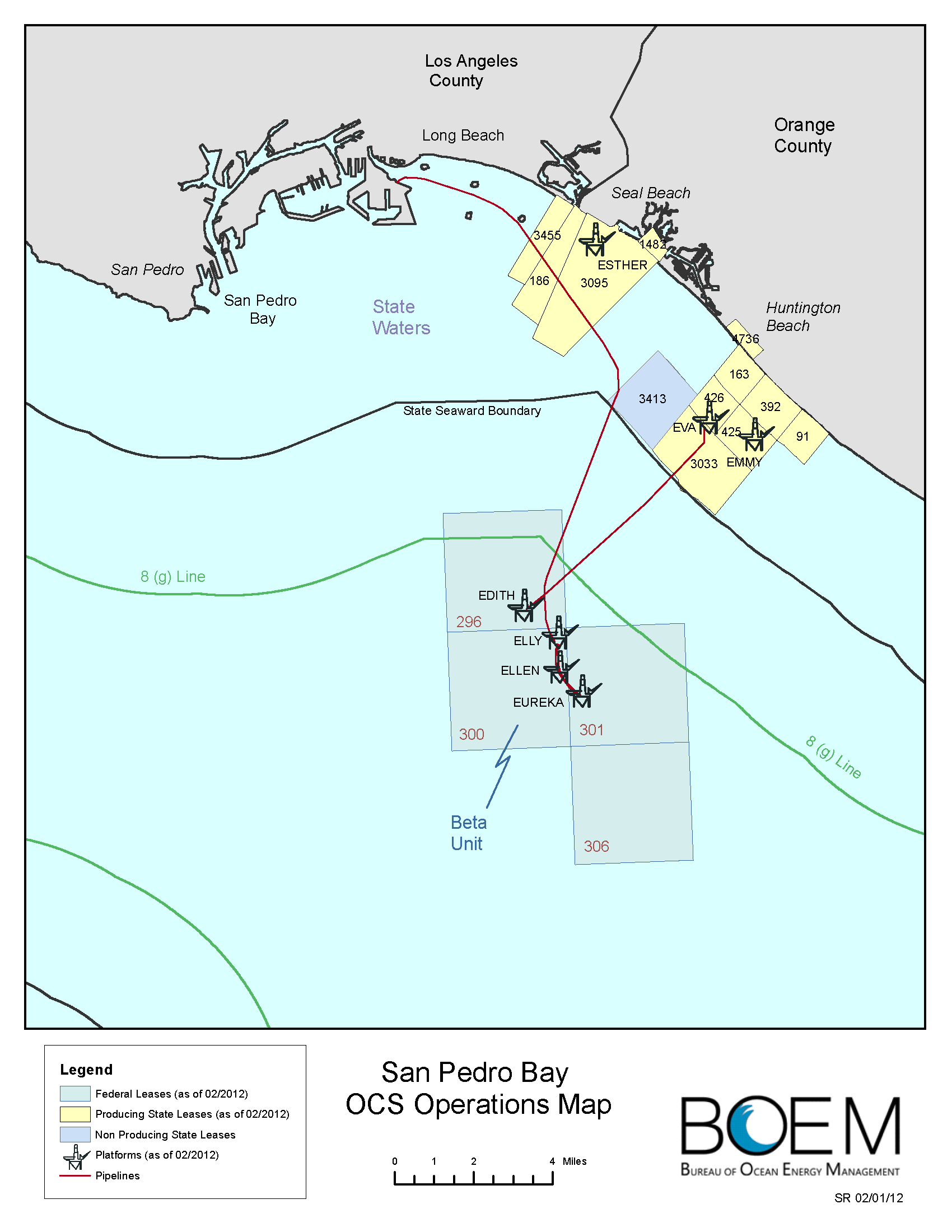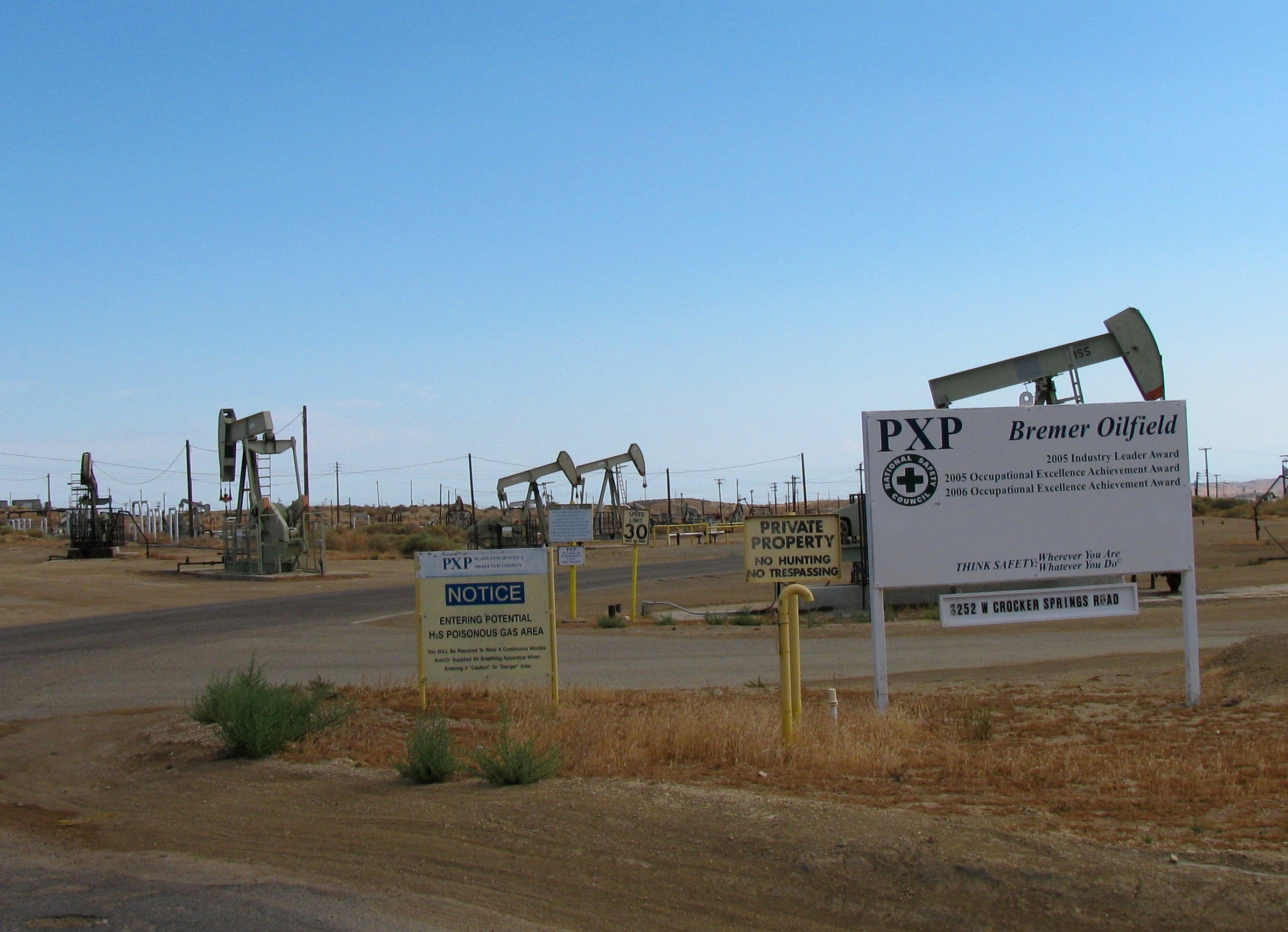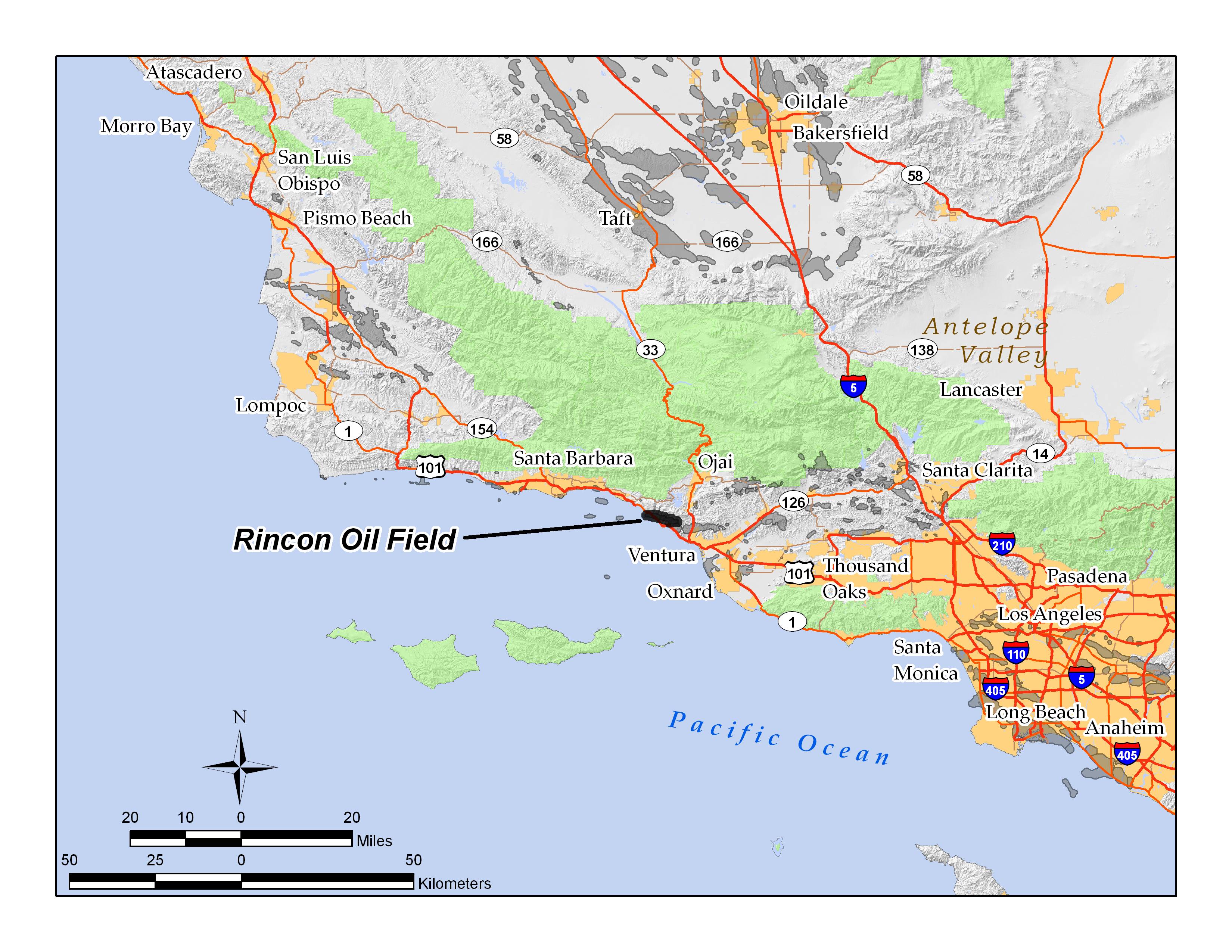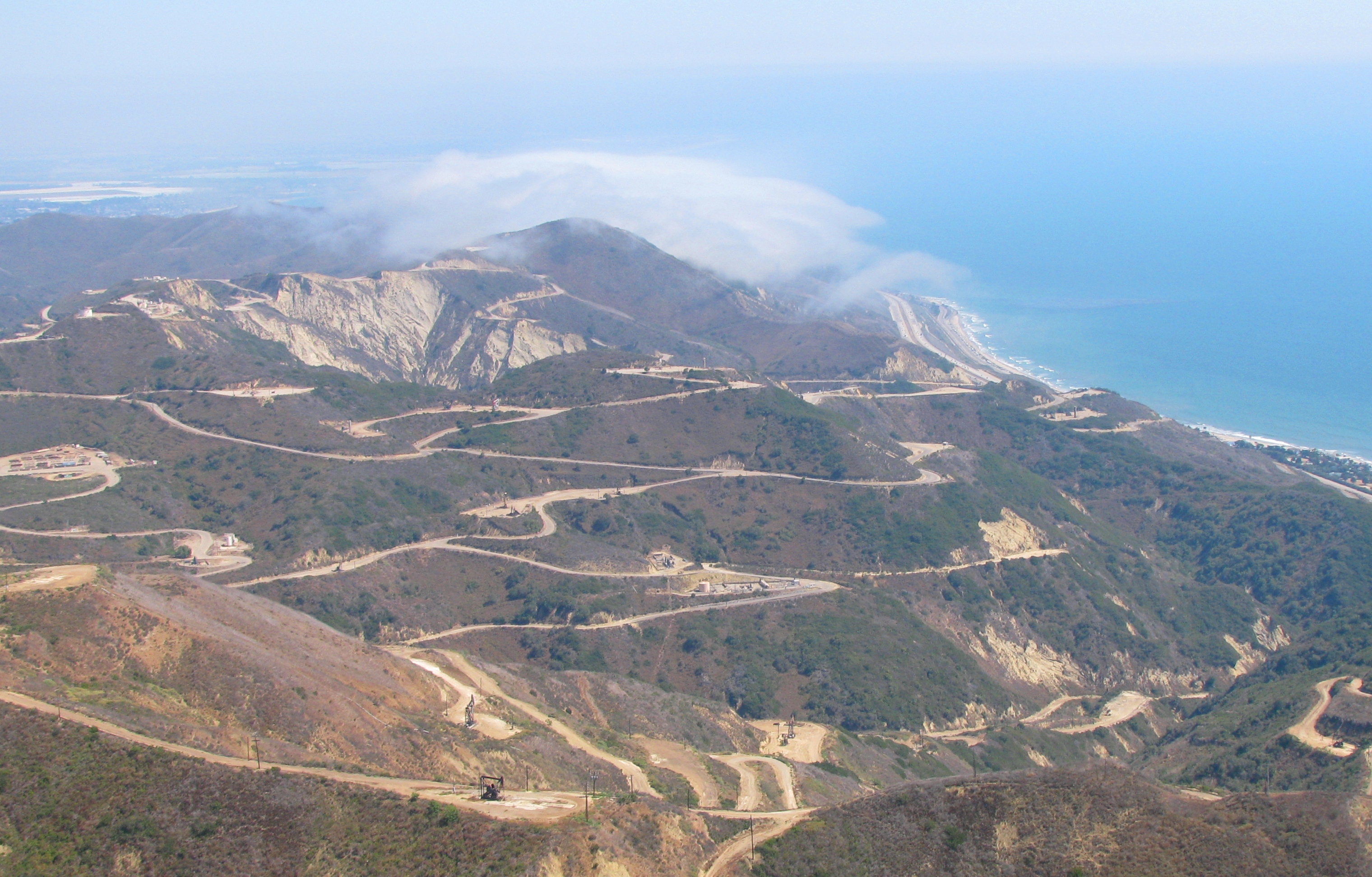|
Carpinteria Offshore Oil Field
The Carpinteria Offshore Oil Field is an oil and gas field in Santa Barbara Channel, south of the city of Carpinteria, California, Carpinteria in southern California in the United States. Discovered in 1964, and reaching peak production in 1969, it has produced over 106 million barrels of oil in its lifetime, and retains approximately 2 million barrels in reserve recoverable with present technology, according to the California State Department of Natural Resources. p. 63. Currently the field is produced from three drilling platforms four to five miles (8 km) offshore, within Federal waters outside of the tidelands zone. Two of the platforms are operated by Pacific Operators Offshore LLC (PACOPS), the operating arm of Carpinteria-based Carone Petroleum; the other platform is operated by Dos Cuadras Offshore Resources (DCOR). The Carpinteria field is the 50th largest field in California by total original oil in place, as of the end of 2008. The Carpinteria field is one of the on ... [...More Info...] [...Related Items...] OR: [Wikipedia] [Google] [Baidu] |
United States
The United States of America (U.S.A. or USA), commonly known as the United States (U.S. or US) or America, is a country primarily located in North America. It consists of 50 states, a federal district, five major unincorporated territories, nine Minor Outlying Islands, and 326 Indian reservations. The United States is also in free association with three Pacific Island sovereign states: the Federated States of Micronesia, the Marshall Islands, and the Republic of Palau. It is the world's third-largest country by both land and total area. It shares land borders with Canada to its north and with Mexico to its south and has maritime borders with the Bahamas, Cuba, Russia, and other nations. With a population of over 333 million, it is the most populous country in the Americas and the third most populous in the world. The national capital of the United States is Washington, D.C. and its most populous city and principal financial center is New York City. Paleo-Americ ... [...More Info...] [...Related Items...] OR: [Wikipedia] [Google] [Baidu] |
Ventura Oil Field
The Ventura Oil Field is a large and currently productive oil field A petroleum reservoir or oil and gas reservoir is a subsurface accumulation of hydrocarbons contained in porous or fractured rock formations. Such reservoirs form when kerogen (ancient plant matter) is created in surrounding rock by the presen ... in the hills immediately north of the city of Ventura, California, Ventura in southern California in the United States. It is bisected by California State Route 33, the freeway connecting Ventura to Ojai, California, Ojai, and is about eight miles (13 km) long by two across, with the long axis aligned east to west. Discovered in 1919, and with a cumulative production of just under a billion barrels of oil as of 2008, it is the tenth-largest producing oil field in California, retaining approximately 50 million barrels in reserve, and had 423 wells still producing. it was entirely operated by Aera Energy LLC. Geographic setting The oil field is on and beneat ... [...More Info...] [...Related Items...] OR: [Wikipedia] [Google] [Baidu] |
Oil Fields In Santa Barbara County, California
An oil is any nonpolar chemical substance that is composed primarily of hydrocarbons and is hydrophobic (does not mix with water) & lipophilic (mixes with other oils). Oils are usually flammable and surface active. Most oils are unsaturated lipids that are liquid at room temperature. The general definition of oil includes classes of chemical compounds that may be otherwise unrelated in structure, properties, and uses. Oils may be animal, vegetable, or petrochemical in origin, and may be volatile or non-volatile. They are used for food (e.g., olive oil), fuel (e.g., heating oil), medical purposes (e.g., mineral oil), lubrication (e.g. motor oil), and the manufacture of many types of paints, plastics, and other materials. Specially prepared oils are used in some religious ceremonies and rituals as purifying agents. Etymology First attested in English 1176, the word ''oil'' comes from Old French ''oile'', from Latin ''oleum'', which in turn comes from the Greek (''elaio ... [...More Info...] [...Related Items...] OR: [Wikipedia] [Google] [Baidu] |
Offshore Oil And Gas In California
Offshore oil and gas in California provides a significant portion of the state's petroleum production. Offshore oil and gas has been a contentious issue for decades, first over the question of state versus federal ownership, but since 1969 mostly over questions of resource development versus environmental protection. Notable offshore fields include the Ellwood Oil Field and the Wilmington Oil Field, both of which are partially onshore and partially offshore, and the large Dos Cuadras Field in the Santa Barbara Channel, which is entirely in the federal zone. State offshore seabed in California produced of oil per day, and federal offshore tracts produced of oil per day in November 2008. State and federal offshore tracts together made up 16% of the state's oil production. Pre-oil industry Knowledge of the probable existence of oil off the coast of California dates back to the early European explorers who noted oil slicks in the Santa Barbara channel (see ''Coal Oil Point s ... [...More Info...] [...Related Items...] OR: [Wikipedia] [Google] [Baidu] |
Directional Drilling
Directional drilling (or slant drilling) is the practice of drilling non-vertical bores. It can be broken down into four main groups: oilfield directional drilling, utility installation directional drilling, directional boring (horizontal directional drilling - HDD), and surface in seam (SIS), which horizontally intersects a vertical bore target to extract coal bed methane. History Many prerequisites enabled this suite of technologies to become productive. Probably, the first requirement was the realization that oil wells, or water wells, do not necessarily need to be vertical. This realization was quite slow, and did not really grasp the attention of the oil industry until the late 1920s when there were several lawsuits alleging that wells drilled from a rig on one property had crossed the boundary and were penetrating a reservoir on an adjacent property. Initially, proxy evidence such as production changes in other wells was accepted, but such cases fueled the development of ... [...More Info...] [...Related Items...] OR: [Wikipedia] [Google] [Baidu] |
Plains Exploration & Production
Plains Exploration & Production was a petroleum and natural gas exploration company based in Houston, Texas. In May 2013, it was acquired by Freeport-McMoRan. History In 2002, the company was separated from Plains Resources Inc. via a corporate spin-off. In 2003, the company acquired 3TEC for $313 million. In 2004, it and acquired Nuevo Energy for $945 million. These acquisitions gave the company petroleum-producing assets in the Southwestern United States and California. In 2007, the company acquired Pogo Producing for $3.6 billion in cash and stock. In 2008, the company formed a joint venture with Chesapeake Energy in the Haynesville Shale. To fund the venture, the company sold assets in the Permian Basin and the Piceance Basin to Occidental Petroleum for $1.3 billion. In 2011, the company sold natural gas assets for $785 million, including a $600 million sale of assets in the Granite Wash to Linn Energy. In 2012, the company acquired assets in the Gulf of Mexico from BP ... [...More Info...] [...Related Items...] OR: [Wikipedia] [Google] [Baidu] |
API Gravity
The American Petroleum Institute gravity, or API gravity, is a measure of how heavy or light a petroleum liquid is compared to water: if its API gravity is greater than 10, it is lighter and floats on water; if less than 10, it is heavier and sinks. API gravity is thus an inverse measure of a petroleum liquid's density relative to that of water (also known as specific gravity). It is used to compare densities of petroleum liquids. For example, if one petroleum liquid is less dense than another, it has a greater API gravity. Although API gravity is mathematically a dimensionless quantity (see the formula below), it is referred to as being in 'degrees'. API gravity is graduated in degrees on a hydrometer instrument. API gravity values of most petroleum liquids fall between 10 and 70 degrees. In 1916, the U.S. National Bureau of Standards accepted the Baumé scale, which had been developed in France in 1768, as the U.S. standard for measuring the specific gravity of liquids less den ... [...More Info...] [...Related Items...] OR: [Wikipedia] [Google] [Baidu] |
Stratigraphic Trap
In petroleum geology, a trap is a geological structure affecting the reservoir rock and caprock of a petroleum system allowing the accumulation of hydrocarbons in a reservoir. Traps can be of two types: stratigraphic or structural. Structural traps are the most important type of trap as they represent the majority of the world's discovered petroleum resources. Structural traps A structural trap is a type of geological trap that forms as a result of changes in the structure of the subsurface, due to tectonic, diapiric, gravitational and compactional processes. Anticlinal trap An anticline is an area of the subsurface where the strata have been pushed into forming a domed shape. If there is a layer of impermeable rock present in this dome shape, then hydrocarbons can accumulate at the crest until the anticline is filled to the ''spill point'' - the highest point where hydrocarbons can escape the anticline. This type of trap is by far the most significant to the hydrocarbon ... [...More Info...] [...Related Items...] OR: [Wikipedia] [Google] [Baidu] |
Rincon Oil Field
The Rincon Oil Field is a large oil field on the coast of southern California, about northwest of the city of Ventura, and about east-southeast of the city of Santa Barbara. It is the westernmost onshore field in a series of three fields which follow the Ventura Anticline, an east-west trending feature paralleling the Transverse Ranges. Discovered in 1927, the oil field is ranked 36th in California by size of recoverable oil reserves, and while mostly depleted – now having, by California Department of Conservation estimates, only about 2.5% of its original oil – it remains productive, with 77 wells active at the beginning of 2008. Oil produced in the field flows through the M-143 pipeline, which parallels U.S. Highway 101 southeast to the Ventura Pump Station, at which point it joins a Tosco pipeline which carries it to Los Angeles area refineries. As of 2009, the primary operators of the field were Occidental Petroleum for the onshore portion, and Greka Energy for the ... [...More Info...] [...Related Items...] OR: [Wikipedia] [Google] [Baidu] |
San Miguelito Oil Field
The San Miguelito Oil Field is a large and currently productive oil field in the hills northwest of the city of Ventura in southern California in the United States. The field is close to the coastline, with U.S. Highway 101 running past at the base of the hills, and is sandwiched between the larger Ventura Oil Field to the east and the Rincon Oil Field, which is partially offshore, to the north and northwest. Discovered in 1931, and with about 7 million barrels of oil remaining out of its original 125 million, it ranks 44th in the state by size, and at the beginning of 2009 had 61 producing oil wells, all operated by Vintage Production California LLC, a subsidiary of Occidental Petroleum. p. 63, 165 Geographic setting The oil field is one of several following the east-west trend of the Transverse Ranges: to the west is the Rincon Oil Field and the offshore Dos Cuadras field, and to the east the much larger Ventura Oil Field. Total productive area of the field, projected to the s ... [...More Info...] [...Related Items...] OR: [Wikipedia] [Google] [Baidu] |
Ventura, California
Ventura, officially named San Buenaventura (Spanish for "Saint Bonaventure"), is a city on the Southern Coast of California and the county seat of Ventura County. The population was 110,763 at the 2020 census. Ventura is a popular tourist destination, owing to its historic landmarks, beaches, and resorts. Ventura was founded by the Spanish in 1782, when Saint Junípero Serra established Mission San Buenaventura. Following the Mexican secularization of the Californian missions, San Buenaventura was granted by Governor Pío Pico to Don José de Arnaz as Rancho Ex-Mission San Buenaventura and a small community arose. Following the American Conquest of California, San Buenaventura eventually incorporated as a city in 1866. The 1920s brought a major oil boom, which along with the post–World War II economic expansion, significantly developed and expanded Ventura. History Archaeological discoveries in the area suggest that humans have populated the region for at least 10,000 ... [...More Info...] [...Related Items...] OR: [Wikipedia] [Google] [Baidu] |






.png)


_(cropped).jpg)